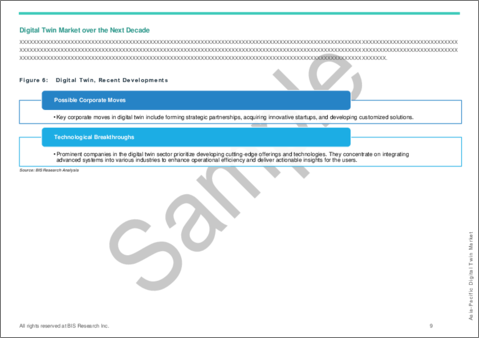|
|
市場調査レポート
商品コード
1599908
アジア太平洋のデジタルツイン市場:用途・エンドユーザー・タイプ・提供製品・国別の分析・予測 (2023-2033年)Asia-Pacific Digital Twin Market: Focus on Application, End User, Type, Product Offering, and Country - Analysis and Forecast, 2023-2033 |
||||||
カスタマイズ可能
|
|||||||
| アジア太平洋のデジタルツイン市場:用途・エンドユーザー・タイプ・提供製品・国別の分析・予測 (2023-2033年) |
|
出版日: 2024年11月29日
発行: BIS Research
ページ情報: 英文 54 Pages
納期: 1~5営業日
|
全表示
- 概要
- 図表
- 目次
アジア太平洋地域のデジタルツインの市場規模は、2023年の25億米ドルから、予測期間中は58.64%のCAGRで推移し、2033年には2,565億米ドルに達すると予測されています。
アジア太平洋地域では、実際のシステム、プロセス、オブジェクトの仮想コピーであるデジタルツインが、業務の改善やイノベーションの促進にますます利用されるようになっています。デジタルツインは、IoT、AI、機械学習、ビッグデータを組み合わせることで、製造、医療、都市計画などの分野でリアルタイムのシミュレーションを可能にします。これらの高度なモデルは、有形資産からのセンサーデータを活用し、判断を強化し、予測を提供し、手続きを迅速化します。
デジタルツインは、特にメンテナンスの最適化やライフサイクル管理などの分野で、アジア太平洋地域の効率化とイノベーション戦略に革命をもたらしています。各分野が近代化を進め、複雑な問題に取り組む中で、デジタルツイン技術の活用は急速に加速しています。これにより、事業の運営方法が変化し、よりインテリジェントでデータ駆動型の戦略が推奨されています。
| 主要市場統計 | |
|---|---|
| 予測期間: | 2023-2033年 |
| 2023年評価: | 25億米ドル |
| 2033年予測: | 2,565億米ドル |
| CAGR | 58.64% |
アジアのデジタルツイン市場は、さまざまな分野で創造性と業務効率を高める最先端技術への需要が高まっているため、急速に拡大しています。デジタルツインは、実際の資産、システム、手順の仮想コピーであり、都市計画、製造、ヘルスケア、自動車などの業界で利用されています。デジタルツインは、IoT、AI、機械学習、ビッグデータを組み合わせることで、リアルタイムのシミュレーションと予測分析を提供します。これにより、保守管理、最適化、意思決定の改善のための重要な洞察が得られます。
中国、日本、韓国、インドなどの国が市場をリードしており、これらの地域の企業は、デジタルツイン技術を使用して効率性を高め、経費を削減し、デジタル変革プロセスを迅速化しています。スマートシティへの注目の高まり、インダストリー4.0、リンクされたデバイスの普及などが市場をさらに牽引しています。アジア太平洋地域が技術的進歩を優先し続ける中で、各種業界が業務を管理・最適化する方法に革命をもたらしならが、デジタルツイン市場は大幅に拡大する見通しです。
市場の分類:
セグメンテーション1:用途別
- 製品設計開発
- 性能モニタリング
- 予知保全
- 在庫管理
- その他
セグメンテーション2:エンドユーザー別
- 製造
- 自動車
- 航空
- エネルギー・ユーティリティ
- ヘルスケア
- 物流・小売
- その他
セグメンテーション3:タイプ別
- アセットデジタルツイン
- プロセスデジタルツイン
- システムデジタルツイン
- 組織デジタルツイン (DTO)
セグメンテーション4:提供製品別
- プラットフォーム
- ハードウェア
- サポートサービス
セグメンテーション5:国別
- 中国
- インド
- 日本
- その他
当レポートでは、アジア太平洋地域のデジタルツインの市場を調査し、業界の動向、技術・特許の動向、法規制環境、市場成長促進要因・抑制要因、市場規模の推移・予測、各種区分・主要国別の詳細分析、競合情勢、主要企業のプロファイルなどをまとめています。
目次
エグゼクティブサマリー
範囲と定義
第1章 市場
- 動向:現在および将来の影響評価
- インフラ開発におけるデジタルツインの台頭
- ハイパーパーソナライゼーション
- エコシステム/進行中のプログラム
- Project PLATEAU
- インダストリー5.0におけるデジタルツインの役割
- 業界別のユースケース
- スタートアップによる資金調達の概要
- 市場力学の概要
- 市場促進要因
- 市場抑制要因
- 市場機会
- サプライチェーンの概要
第2章 地域
- 地域別概要
- アジア太平洋
- 地域概要
- 市場成長の原動力
- 市場課題
- 中国
- インド
- 日本
- その他
- 用途
- 製品
第3章 市場:競合ベンチマーキングと企業プロファイル
- 次なるフロンティア
- 地理的評価
第4章 調査手法
List of Figures
- Figure 1: Digital Twin Market (by Region), $Billion, 2022, 2023, and 2033
- Figure 2: Asia-Pacific Digital Twin Market (by Application), $Billion, 2022, 2023, and 2033
- Figure 3: Asia-Pacific Digital Twin Market (by End User), $Billion, 2022, 2023, and 2033
- Figure 4: Asia-Pacific Digital Twin Market (by Product Offering), $Billion, 2022, 2023, and 2033
- Figure 5: Asia-Pacific Digital Twin Market (by Type), $Billion, 2022, 2023, and 2033
- Figure 6: Digital Twin, Recent Developments
- Figure 7: Impact Analysis of Market Navigating Factors, 2022-2033
- Figure 8: Supply Chain and Risks within the Supply Chain
- Figure 9: China Digital Twin Market, $Billion, 2022-2033
- Figure 10: India Digital Twin Market, $Billion, 2022-2033
- Figure 11: Japan Digital Twin Market, $Billion, 2022-2033
- Figure 12: Rest-of-Asia-Pacific Digital Twin Market, $Billion, 2022-2033
- Figure 13: Strategic Initiatives, 2020-2023
- Figure 14: Share of Strategic Initiatives, 2020-2023
- Figure 15: Data Triangulation
- Figure 16: Top-Down and Bottom-Up Approach
- Figure 17: Assumptions and Limitations
List of Tables
- Table 1: Market Snapshot
- Table 2: Digital Twin Market, Opportunities across Regions
- Table 3: Funding and Investment Scenario, February 2022-February 2024
- Table 4: Digital Twin Market (by Region), $Billion, 2022-2033
- Table 5: Asia-Pacific Digital Twin Market (by End User), $Billion, 2022-2033
- Table 6: Asia-Pacific Digital Twin Market (by Application), $Billion, 2022-2033
- Table 7: Asia-Pacific Digital Twin Market (by Type), $Billion, 2022-2033
- Table 8: Asia-Pacific Digital Twin Market (by Product Offering), $Billion, 2022-2033
- Table 9: China Digital Twin Market (by End User), $Billion, 2022-2033
- Table 10: China Digital Twin Market (by Application), $Billion, 2022-2033
- Table 11: China Digital Twin Market (by Type), $Billion, 2022-2033
- Table 12: China Digital Twin Market (by Product Offering), $Billion, 2022-2033
- Table 13: India Digital Twin Market (by End User), $Billion, 2022-2033
- Table 14: India Digital Twin Market (by Application), $Billion, 2022-2033
- Table 15: India Digital Twin Market (by Type), $Billion, 2022-2033
- Table 16: India Digital Twin Market (by Product Offering), $Billion, 2022-2033
- Table 17: Japan Digital Twin Market (by End User), $Billion, 2022-2033
- Table 18: Japan Digital Twin Market (by Application), $Billion, 2022-2033
- Table 19: Japan Digital Twin Market (by Type), $Billion, 2022-2033
- Table 20: Japan Digital Twin Market (by Product Offering), $Billion, 2022-2033
- Table 21: Rest-of-Asia-Pacific Digital Twin Market (by End User), $Billion, 2022-2033
- Table 22: Rest-of-Asia-Pacific Digital Twin Market (by Application), $Billion, 2022-2033
- Table 23: Rest-of-Asia-Pacific Digital Twin Market (by Type), $Billion, 2022-2033
- Table 24: Rest-of-Asia-Pacific Digital Twin Market (by Product Offering), $Billion, 2022-2033
- Table 25: Market Share, 2022
Introduction to Asia-Pacific Digital Twin Market
The Asia-Pacific digital twin market is projected to reach $256.5 billion by 2033 from $2.5 billion in 2023, growing at a CAGR of 58.64% during the forecast period 2023-2033. In APAC, digital twins-virtual copies of actual systems, processes, or objects-are being used more and more to improve operations and spur innovation. Digital twins allow real-time simulations for sectors like manufacturing, healthcare, and urban planning by combining IoT, AI, machine learning, and big data. These sophisticated models make use of sensor data from tangible assets to enhance judgment, provide forecasts, and expedite procedures.
Digital twins are revolutionizing efficiency and innovation strategies in the Asia-Pacific area, especially in fields like maintenance optimization and lifecycle management. The use of digital twin technology is quickly accelerating as sectors work to modernize and tackle complicated issues. This is changing how businesses operate and encouraging more intelligent, data-driven strategies.
| KEY MARKET STATISTICS | |
|---|---|
| Forecast Period | 2023 - 2033 |
| 2023 Evaluation | $2.5 Billion |
| 2033 Forecast | $256.5 Billion |
| CAGR | 58.64% |
Market Introduction
The market for digital twins in Asia is expanding quickly because to rising demand for cutting-edge technologies that boost creativity and operational effectiveness in a range of sectors. Digital twins, which are virtual copies of real assets, systems, or procedures, are being used in industries like urban planning, manufacturing, healthcare, and automobiles. Digital twins provide real-time simulations and predictive analytics by combining IoT, AI, machine learning, and big data. This offers important insights for improved maintenance management, optimization, and decision-making.
Leading the way are nations like China, Japan, South Korea, and India, as companies there use digital twin technologies to boost efficiency, cut expenses, and quicken the digital transformation process. The increasing focus on smart cities, Industry 4.0, and the proliferation of linked devices are driving the market even more. As the APAC region continues to prioritize technological advancements, the digital twin market is set for substantial expansion, revolutionizing how industries manage and optimize their operations.
Market Segmentation:
Segmentation 1: by Application
- Product Design Development
- Performance Monitoring
- Predictive Maintenance
- Inventory Management
- Others
Segmentation 2: by End User
- Manufacturing
- Automotive
- Aviation
- Energy and Utilities
- Healthcare
- Logistics and Retail
- Others
Segmentation 3: by Type
- Asset Digital Twin
- Process Digital Twin
- System Digital Twin
- Digital Twin of an Organization (DTO)
Segmentation 4: by Product Offering
- Platforms
- Hardware
- Support Services
Segmentation 5: by Country
- China
- India
- Japan
- Rest-of-Asia-Pacific
How can this report add value to an organization?
Product/Innovation Strategy: The product segment helps the reader understand the different types of products available for deployment in Asia-Pacific Region. Moreover, the study provides the reader with a detailed understanding of the Asia-Pacific digital twin market based on application (product design development, performance monitoring, predictive maintenance, inventory management, and others), and by end user (manufacturing, automotive, aviation, energy and utilities, healthcare, logistics and retail, and others), on the basis product offering (platform, hardware, and software service), and by type(Asset Digital Twin, Process Digital Twin, System Digital Twin, and Digital Twin of an Organization (DTO).
Growth/Marketing Strategy: The Asia-Pacific digital twin market has seen major development by key players operating in the market, such as business expansion, partnership, collaboration, and joint venture. The favored strategy for the companies has been partnerships and contracts to strengthen their position in the Asia-Pacific digital twin market.
Table of Contents
Executive Summary
Scope and Definition
1 Markets
- 1.1 Trends: Current and Future Impact Assessment
- 1.1.1 Rise of Digital Twins in Infrastructure Development
- 1.1.2 Hyper-Personalization
- 1.2 Ecosystem/Ongoing Programs
- 1.2.1 Project PLATEAU
- 1.3 Role of Digital Twin in Industry 5.0
- 1.4 Use Cases by Industry
- 1.5 Startup Funding Summary
- 1.6 Market Dynamics Overview
- 1.6.1 Market Drivers
- 1.6.1.1 Increasing Adoption of AI, ML, IoT, Data Analytics, and 5G
- 1.6.1.2 Increasing Investment in Digital Twin City
- 1.6.2 Market Restraints
- 1.6.2.1 Technical Hurdles in Digital Twin Implementation
- 1.6.2.2 Scaling and High Fidelity
- 1.6.3 Market Opportunities
- 1.6.3.1 Increasing Use of Digital Twin across Various Industries
- 1.6.1 Market Drivers
- 1.7 Supply Chain Overview
2 Regions
- 2.1 Regional Summary
- 2.2 Asia-Pacific
- 2.2.1 Regional Overview
- 2.2.2 Driving Factors for Market Growth
- 2.2.3 Factors Challenging the Market
- 2.2.4 Application
- 2.2.5 Product
- 2.2.6 China
- 2.2.7 Application
- 2.2.8 Product
- 2.2.9 India
- 2.2.10 Application
- 2.2.11 Product
- 2.2.12 Japan
- 2.2.13 Application
- 2.2.14 Product
- 2.2.15 Rest-of-Asia-Pacific
- 2.2.16 Application
- 2.2.17 Product
3 Markets - Competitive Benchmarking & Company Profiles
- 3.1 Next Frontiers
- 3.2 Geographic Assessment
4 Research Methodology
- 4.1 Data Sources
- 4.1.1 Primary Data Sources
- 4.1.2 Secondary Data Sources
- 4.1.3 Data Triangulation
- 4.2 Market Estimation and Forecast





